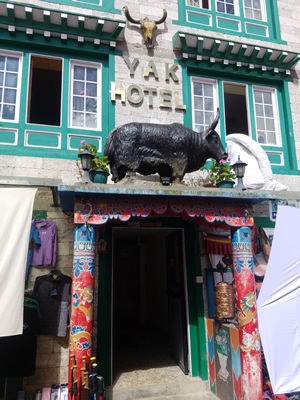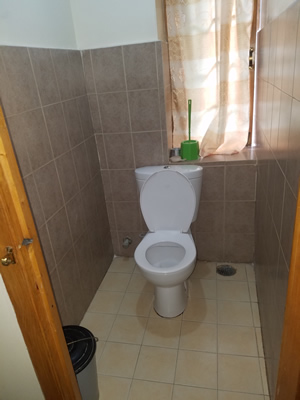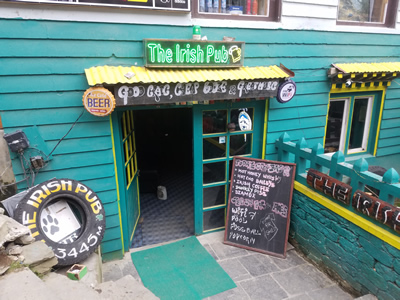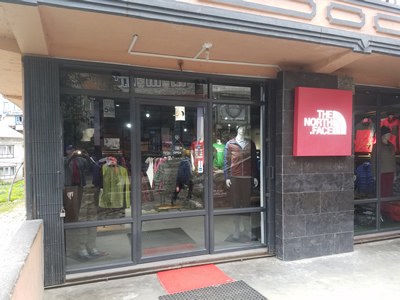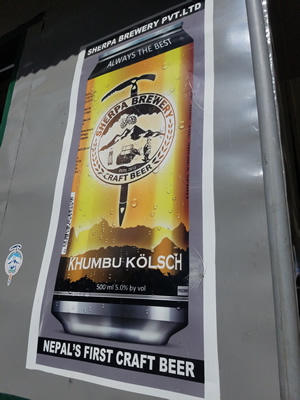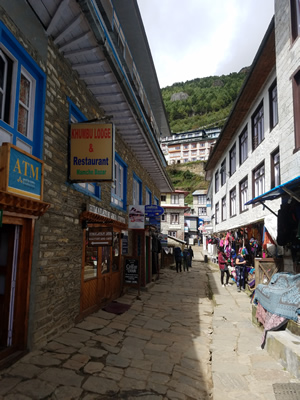Nepal Pt7: Changes
Namche Bazaar is the largest town in the Khumbu region. It's population is listed as 1647 people but that number is from a census taken in 2001. It has undoubtedly grown substantially since then. The town originally was a stop on a major trade route between Nepal and Tibet that ran through the Bhote Khosi valley. Now it is a major center for the tourist industry. Virtually every climber or trekker who goes to the Everest region passes through Namche. Because it is the first high village reached on the way to Mt. Everest, almost everyone stays there one or more nights to acclimatize. That included Shambu and I on this trip.
It only took us half a day to walk here from Monjo, where we had stayed the night before. After lunch we did a short acclimatization hike. Then I had the rest of the afternoon and evening free to explore the town. I had been here before, on my first trip to Nepal twenty seven years earlier. I was interested in seeing how things had changed since then.
When I was here in 1990 it was already a busy place. There were a lot of lodges and shops and restaurants. The town was filled with foreign trekkers. But while it was heavily tourist oriented, it still seemed like a high mountain village in Nepal. The people, their dress, the food, the buildings, the facilities and services available (or in most cases, not available), all made you feel like you were in a remote part of the Himalayas. After spending a day and a night in Namche in 2017 I decided that it's a lot more like a mountain resort now.
Some of the differences between past and present were obvious as soon as I got to our lodge. The Yak Hotel, like any other modern business, has its own website and is rated on TripAdvisor. Electricity used to be limited. Lodges had just a few lights and they all went off at 10 pm when the town turned off its generator. Now electricity is provided 24/7 by a small hydroelectric plant near the village of Thame. There are lights everywhere. Even more important for twenty first century trekkers, there are outlets in every room so that they can charge their personal electronic devices. I have to admit that it mattered to me. Although I carried a small DSLR camera with a battery that lasted for the whole trip, I actually took most of my pictures with my Galaxy S7 phone. It was easy to carry in my pocket where it was readily available and it took great shots. Even though I kept it in airplane mode I still needed to charge it every three days.
The most important change was in sanitation. On my first visit I traveled for seven weeks in the mountains and never saw a flush toilet. On the trail we used the bushes and in town there were pit toilets, and usually rather unpleasant ones at that. In the Yak Hotel there was a flush toilet on every floor and the bathroom, even though a common one, was kept quite clean. When you travel in a third world country you really learn to appreciate the importance of good bathroom facilities because you can't take them for granted.
Communications were much improved. I had excellent cell phone service. I took advantage of it to call Sandy and talk to her. Many lodges throughout the Khumbu had wifi, although since they charged for it the only place that I used it was here at the Yak Hotel. I didn't expect it to work well but I figured Namche would be my best bet. When I tried to use it that evening it turned out that even here it was terrible. It was so slow that when I tried to access a web page it would start to load but would be so slow that it always timed out and gave an error. It was unusable. I got around that by taking advantage of the fact that my sleeping schedule was still skewed. When I woke up the next morning at 5 am I got dressed and came down to the common room. No one else was crazy enough to be up at that hour so I got reasonable network performance. I checked my email and scanned the news from the outside world. Sadly, I learned that Trump was still president. I even checked in on Facebook and posted a few pictures.
Another big change was ventilation. Traditional sherpa houses did not have chimneys. On my first trip, on cold days it was always a tough decision. Do I stay outside and freeze? Or do I go inside where I'll cough and choke and get bleary eyed because of the smoke. Every sherpa must have been half-blind from cataracts by the time they were forty. Now I didn't see a single building where the fireplace or stove wasn't vented to the outside. It was a big improvement.
Things looked a lot different as I walked around town too. There was an ATM right across from my hotel. There were still a lot of traditional Nepali shops, where merchandise was piled in boxes or laid out on tables. But there were also western-style stores that wouldn't look out of place in a US suburban mall, especially stores selling things like high-end hiking and trekking gear. There was even a real North Face store.
There were a lot of choices for food and drink. Traditional teahouses used to be a little like being a guest in someone's house. They would offer traditional Nepali foods like dal bhat (rice and lentil soup), chapatis (a flatbread) or momos (Tibetan dumplings). Now just about every restaurant had added things like spaghetti, pizza and french fries to their menu. In Namche there were even places that specialized in other cuisines. I saw a Japanese sushi restaurant, a German bakery, several Starbucks-like coffee houses, two Irish pubs, and many others.
And bars. There were a lot of bars. As I walked past them there would be loud music blaring from inside. It was quite a change for a place that barely had electric lights the last time I was here. The traditional Sherpa alcoholic drink is chang, which is made from barley and is similar to beer. But there was a wide variety of other choices, from imported beers like Guiness to locally brewed beers like Everest (what else would you call a beer brewed in Nepal?). Apparently a lot of tourists get bored during their acclimatization layover in Namche and spend their time drinking. That's actually not a good idea since alchohol and altitude interact and mutually amplify their effects.
I thought these businesses were all pretty remarkable when you consider that it takes four or five days of walking to get to Namche from the nearest road. It did explain all of those long trains of pack animals that shared the trail with us on our hike in.
Even the Sherpa people look different. On my first visit they wore traditional clothes, especially the women, that were mostly made from yak wool. Now everyone dressed in western clothes. They were wearing synthetic hiking pants, down jackets and hiking boots. Used gear is readily available and very cheap. Many westerners, from big climbing expeditions to solo trekkers don't want to haul all of their mountain clothes and equipment back home when they leave Nepal. I left some of my stuff at the end of the trip too, letting Shambu and Awshuk take what they wanted.
The atmosphere in Namche and the whole Khumbu has changed dramatically over time, but the tourist business has been very good for the area. Namche is the wealthiest district in Nepal, with an annual income that is seven times the national average. Some people might lament the loss of the way things were and resent the commercialization that has occured. But it is clear that there has been tremendous improvement in the way of life for the people who live there. I think that is a good thing.
